Guy Beam
“The Forgotten Guy”
Guy Smallwood Beam’s story is a lesser-known, yet critical chapter in the proud saga of international whiskey-making. Born January 11, 1885, in Bardstown, Kentucky, Guy carried the weight of a family legacy that dated back 100 years before his birth, when his ancestor Jacob Beam sold his first barrel of whiskey. The Beam name had, even then, become synonymous with the finest bourbon craftsmanship. As a direct descendant of that family, it was always expected that Guy would advance this time-honored tradition. He did not disappoint.
Once Guy was born to parents Katie Nall Beam and the legendary Minor Case Beam, he was immediately immersed in the intricacies of whiskey production. Growing up surrounded by distillers and barrel makers, he learned firsthand the importance of selecting the right grains, the science of fermentation, and the magic that happened inside charred oak barrels during a whiskey’s years of aging. Once experienced enough, Guy quickly rose to the esteemed position of Master Distiller in at least 3 American distilleries, including Heaven Hill, Fairfield, and Cummins-Collins, in a state where that title is reserved only for those with both a profound understanding of whiskey making and who display an unwavering dedication to quality. His role was more than supervisory; it was stewardship. Every drop of bourbon produced under his watch reflected the Beam family’s relentless pursuit of excellence. Although his innovations might not be as well-documented as some of his relatives, Guy’s contributions were no less significant. He was the quiet guardian of tradition, maintaining strict standards and ensuring that every barrel lived up to the Beam name.
Yet, perhaps the greatest challenge of Guy Beam’s career, and indeed his life, came in 1920, with the start of Prohibition. The 18th Amendment brought the legal production and sale of alcohol to a screeching halt in the United States. Distilleries shuttered, workers dispersed, and family legacies hung in the balance. For the Beam family, whose identity and livelihood were entwined with bourbon, it was a crisis like no other. Guy had married Mary Christine Burch in 1906, and by the time of Prohibition, he had five children to raise. Fortunately, Guy Beam was not a man to surrender to circumstance. Demonstrating resilience and resourcefulness, he made the difficult decision to leave his home country and relocate to Canada, where alcohol production remained legal. In Ontario, Hiram Walker’s Canadian Club Distillery was delighted to have him in their workforce. At Canadian Club, Guy continued the work that had been his birthright, not just distilling whiskey, but preserving the Beam family’s sacred methods and protecting recipes and techniques that might have otherwise been lost during America’s long dry years. It is interesting to note that one of Canadian Club’s most important clients in those days was Chicago gangster Al Capone, who smuggled in thousands of cases of the whiskey through Ontario and into Michigan.
This period in Canada was also not without personal sacrifice. Leaving behind the familiar hills of Kentucky and, more importantly, close familial ties, was no easy task. But also, during his time in Canada, Beam played a critical, if understated, role in safeguarding the future of his craft. While other distillers struggled or gave up entirely, Guy not only made a living for his family but also honed his skills in a foreign land, mastering not only the technical aspects of whiskey making and blending but also the patience and foresight required to endure a crisis of that scale. His work ensured that when Prohibition was finally repealed in 1933, he could quickly return to Kentucky with his family, which he did. He immediately went to work for his dad, Minor Case Beam, who had since reopened Gethsemane Distillery, which was later to be folded into the Limestone Branch family of distilleries by MGP/LuxCo.
The end of Prohibition also meant that Guy Beam could quietly resume his place among the ranks of Beam Master Distillers. Unlike some of his more famous relatives, including his own father, Guy’s story was not one of public acclaim or flashy marketing. Rather, it was a narrative of steady perseverance, a man who did what was necessary to keep his wife and children, as well as an important family tradition, alive during his darkest days.
Guy Beam passed away on January 9, 1962, at the age of 76 in Louisville, Kentucky, having lived long enough to see the American whiskey industry not only recover but flourish once again. He and Mary (who outlived Guy by nearly seven years) had ultimately raised nine children, and two, George and Jack, enjoyed respectable distilling careers themselves. A third, James Paul or “Jimmy”, wasn’t directly involved in distilling himself, but was the father of current Limestone Branch owners and distillers Stephen and Paul Beam.
Much of Guy’s life was a testament to the quiet strength and determination that often go unnoticed but are essential to any lasting success. While many whiskey drinkers may not recognize his name, every sip of either American or Canadian whiskey enjoyed today carries just a bit of the influence of Guy Beam’s careful craftsmanship and indomitable spirit.
In the grand tapestry of the Beam family legacy, Guy Beam’s contributions are comparable to the sturdy threads that hold that fabric together. His personal sacrifices and professional dedication bridged the gap between past and future, ensuring that a craft begun by Jacob Beam over a century earlier could survive war, prohibition, and change. His story reminds us that sometimes, history’s most important figures are not those who find the spotlight, but those who work tirelessly in its dark and sometimes easily forgotten shadow.
Contributed by Harry Casazza, Berkeley Heights, New Jersey






